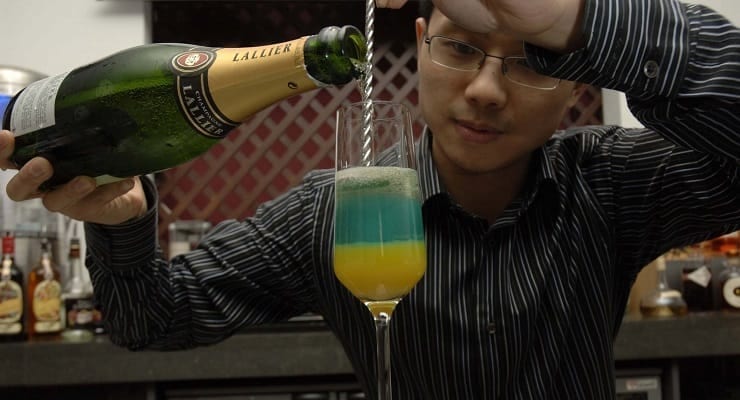Bubble Reputations
17th March 2017

Sparkling cocktails are Fun. But that doesn’t mean they’re trivial.
The difference between a sparkling cocktail and a Champagne Cocktail is that in sparklers the bubbly is an addition to the drink not its base. It doesn’t have to taste of it.
If you think that means the bubbly is there just to turn a short drink into a long one and add value and bubbles, think again. The mix opens out all the ingredients. Structures and hidden tastes are revealed. And if the bubbly’s turns out to be mere mild acidulation on top of nothing much – or uncouth acidity or oxidation – so much the worse for the drink and the choice of bubbly.
Then there’s the mousse itself. The bubbles should last a bit, because texture is really what it’s all about. Sparkling and Champagne cocktails have a different mouth-feel to all others – and they’re lingered over, where ordinary cocktails tend to be drunk quickly.
Finally there’s ‘weight’ and structure. Your bubbly choice is going to find itself in awkward company. Sometimes neutrality is good. But at others vibrancy or sweetness, lightness or weight, will be better – in fact essential. There is no one-fits-all solution. Not even with Champagne.
The Great Unmentionable…
Many sparkling cocktails have their origins in the 19th century – to a time when Champagne was typically much, much sweeter than it is now, and also varied notably depending on which country it was exported to. Champagne in Britain was always the driest, in America it was twice as sweet, in France itself six times… Right up to WW2 it was still generally sweeter than today.
But it’s not just sweetness. The old Champagnes were often also literally older – more rounded, less acidic. So, while there is an argument in favour of using very dry ‘brut zero’ (0-3 gpl added sugar) or ‘extra brut’ (3-6), and sweetening it if you think that is what’s required, the argument for using sec or demi-sec bubbly (17-32, 32-50 gpl sugar) is at least as strong.
And of course, it doesn’t have to be Champagne at all. Nor made with Chardonnay or Pinot. What it does have to be is bottle-fermented (because those bubbles have to keep coming) and 12-12.5 degrees of alcohol. Not less, not more.
Prosecco? No. But Cava certainly: the taste ranges between the ‘sappy’ and ‘neutral’ but it won’t hollow out the cocktail, which Prosecco will. The best alternatives of all are probably sparkling Saumur, whose use as a sub for Champers is traditional because its light weight and attractive acidity is perfect in heavier recipes, and Cremant D’Alsace, whose popularity is soaring everywhere except in Britain. This can be made from combinations of any of the local grapes, but look for a high proportion of Auxerois, a close relative of Chardonnay which gives it Champagne-like weight.
Bubbly in sparkling cocktails shouldn’t dominate or disappear. But what it contributes is invaluable.
AIR MAIL
In a shaker:
30 ml Golden Rum
1 Teaspoon runny honey or agave syrup
Juice ½ lime
Shake
Pour into flute glass, fill with bubbly, stir
BLACK VELVET FANCY
Into a flute glass pour:
10-15 ml iced chocolate liqueur or Cherry Brandy*
Carefully half fill glass with iced stout or dark, malty beer
Fill with iced demi-sec Champagne or off-dry sparkling wine
Stir gently
Orange twist garnish.
* With bitter stout: Mozart Black chocolate liqueur. Otherwise Grant’s or Heering Cherry Brandy.
CAVALIER
Put a sugar cube in a flute glass
Cover with 10 ml Brandy
Add 10 ml Apricot Brandy
Fill with Cava
Stir gently
Lemon twist garnish
Photo: Mango Tree restaurant, London
![]()
Bernard Barbuk
After a career as a business journalist, he wrote on drinks subjects for almost every extant drinks publication. He now divides his time between refining his database of 2,000-plus classic recipes & finishing a book on ‘the 18 Families of the classic cocktail’.
